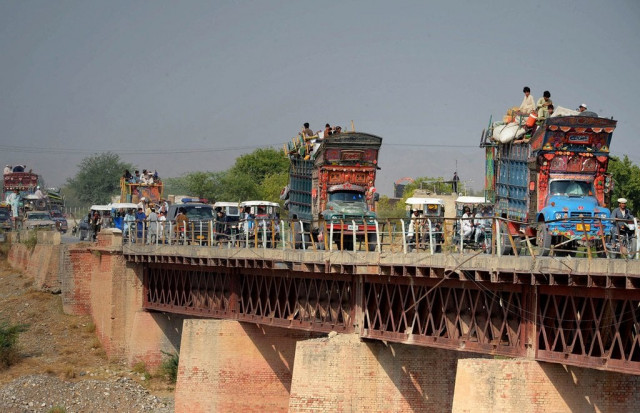A complex emergency
The authorities need to devise a long-term rehabilitation plan for IDPs that is designed to fulfil their basic needs.

Over 9,000 families have been registered but there is reportedly a 20,000 vehicle traffic jam at one of the exit points. PHOTO: AFP

The IDPs were demanding that the government provide them with food and shelter before they allow their children to be vaccinated; their trucks were diverted to a camp in Bannu — which does nothing to solve the problem. There are currently 61,000 IDPs in the Bannu camp, 2,930 of them children. The military has been quick to recognise the opportunity that is being created for children to be vaccinated. The drops will be administered at check posts and at the 20 registration centres that have been set up. The civil administration is also moving quickly to capitalise on the opportunity. The Prime Minister’s Polio Cell is reporting that nearly 40,000 children have been vaccinated in a two-day campaign in Khyber-Pakhtunkhwa (K-P) and Fata, exceeding the target of 37,000. On both, the military and civil sides, a threat has been turned into an opportunity, and it is not a moment too soon.
The failure to eradicate polio has effectively seen Pakistan placed into quarantine by the World Health Organisation (WHO), and documents are now required to prove that a traveller, young or old, has been vaccinated. The number of cases reported in the country in 2014 is seeing an alarming rise. The latest figures (June 14) confirmed four more cases bringing the total to 82 so far this year and the year is not yet half gone. None of the children recently infected had been vaccinated. Fata is the origin of 64 of this year’s cases, followed by K-P with 12 and Sindh with six.
A further layer of complexity, quite apart from the polio crisis, is the IDPs themselves is that June 20 saw the end of the relaxation of the curfew in the North Waziristan Agency, a move designed to facilitate the evacuation of non-combatants and reduce the numbers of civilian casualties as and when a ground offensive commences. Many of those who have elected to leave are occupying government schools and offices rather than the designated camps set up for them, which makes their registration and the provision of services all the more difficult. Over 9,000 families have been registered but there is reportedly a 20,000 vehicle traffic jam at one of the exit points. The Fata Disaster Management Authority states that about 62 per cent of the entire population of North Waziristan has elected to move — a massive migration that is going to have long-term consequences, both social and budgetary.
Expectations of an early return by any of the IDP groups affected by Operation Zarb-e-Azb is low. These populations have left homes and livelihoods, have no means of supporting themselves and are the responsibility of the state, which has a duty of care. They have negligible access to health or education and the provision of jobs for any of them are the remotest of possibilities. The opportunity to vaccinate hitherto inaccessible children is a single bright spot in a bleak landscape. The duration of any ground operation is unknown, but is likely to last weeks or months rather than days. Homes, property and livestock are inevitably going to be damaged or destroyed. What the authorities, therefore, need to do is to devise a long-term rehabilitation plan for the IDPs that is designed to fulfil their basic needs.
Published in The Express Tribune, June 21st, 2014.
Like Opinion & Editorial on Facebook, follow @ETOpEd on Twitter to receive all updates on all our daily pieces.















COMMENTS
Comments are moderated and generally will be posted if they are on-topic and not abusive.
For more information, please see our Comments FAQ